Imiquimod 5% cream (Aldara™, 3M Pharmaceuticals) has shown early promise for the treatment of equine aural plaques and sarcoids of nearly all types and in many locations. Imiquimod is available from most human pharmacies under the trade names of Aldara, Zyclara and Beselna can be dispensed as an off label recommendation. Generic imiquimod is currently available in Canada and may be available in the USA soon if not already. Price shopping is recommended. Online pharmacies tend to have lower prices. Owners can ask their pharmacist if they have a discount program for veterinary patients.
Directions for using Aldara™ on equine aural plaques
The following is our current protocol:
- We recommend treating both ears at the same time to minimize the risk of reinfection.
- Due to ear sensitivity during treatment, we recommend a close partnership between the veterinarian and the owner. Without close assistance, owner compliance is difficult.
- Imiquimod cream should be applied in a very light layer to the inner surface of the ear, covering all plaques.
- This is generally ½ to 1 packet of cream.
- Clipping hair from the ears prior to application eases cleaning and treatment.
- Treatment protocol : 2 to 3x weekly (e.g. Tu-Fri or Tu-Th-Sat) every other week. Due to the inflammatory response, twice weekly has been easier on horses and owners. Treatment duration may be slightly increased.
- Treatment leads to a local inflammatory response, same as for sarcoids except the ear will look worse vs the tumor looks worse.
- It is important to clean the ear well prior to applying the cream. Due to ear sensitivity this often requires sedation and/or twitch application. Some horses respond sufficiently to bribes of food.
- Cleaning is done using water.
- IV sedation works best. We start with xylazine + butorphanol.
- If IM sedation is used, we recommend detomidine + butorphanol.
- The first cleaning and application after the week off is relatively easy.
- The third treatment of a week is the most difficult.
- The amount of inflammation created by the cream can make it difficult to determine if the plaques are still present. We recommend treating for two months (4 treatment weeks) and then reassessing the ear at least one week after the last treatment. Mild scar tissue is possible and can resemble aural plaques. Continue treating if you notice obvious plaques or raised white circular lesions. Suspicious areas should be rechecked one month after treatment is stopped.
- Imiquimod is still under patent as a human product and requires a prescription. We recommend owners price shop and include on line resources. Generally the packets are sold in a box of 12 and this is a good starting amount.
If you or your clients have further questions, please see the Aldara FAQ for Owners section.
You may also contact:
Dr. Erin Malone
612-625-4762 (office)
612-625-6700 (Large Animal main office)
[email protected]
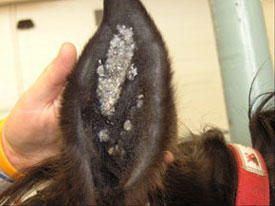
Aural plaque before treatment
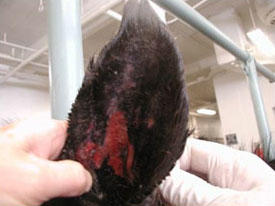
Aural plaque during treatment
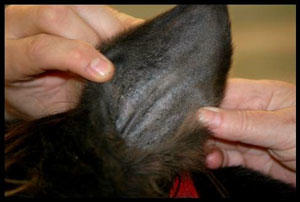
Aural plaque after treatment
Directions for using Aldara™ on equine sarcoids
The following is our current protocol:
- Imiquimod cream should be applied in a very light layer to the tumor(s) three times weekly. We recommend MWF or TuThSat.
- We recommend wearing gloves or washing hands well after using the cream.
- Each tumor should be treated. There does not seem to be a generalized reaction.
- Even occult (covered by hair) tumors have responded. We do not recommend mixing imiquimod with other substances.
- Treatment leads to a local inflammatory response. The drug has been shown to have potent antitumor and antiviral effects. It works by stimulating macrophages, Langerhans cells, natural killers and B lymphocytes through the induction of inflammatory mediators. Expect redness, swelling, oozing, crusts and pain on palpation. The tumor will usually look worse before it looks better.
- It is important to clean the tumor well before applying the cream. This can be painful for the horse. Occasionally horses will require extra restraint or sedation for cleaning. Cleaning is done using mild soap and water. Tumors around the eyes appear to be the hardest to clean.
- If the horse is very resistant or if the pain reaction significant, the horse may be treated with phenylbutazone (1-2 grams daily for average sized horses).
- The frequency of treatment may also be decreased to once or twice weekly until the inflammation decreases. Additionally, resting intervals of 1-2 weeks may help decrease discomfort.
- Side effects can include changes in skin pigmentation (hyper or hypopigmentation). White hairs may develop but do not seem common and were not observed in our study. The skin around the tumor may also be affected. This may be due to extensions of the sarcoid in the dermis. In general, owners have been satisfied with the cosmetic results.
- Systemic effects such as fever, anorexia or other illness are rare. The treatment can be slowed if the horse does not respond to phenylbutazone.
- Pregnant mares (2 in the study) have been treated with the drug and no complications were noted. Foals nursing mares being treated may develop skin irritation if they rub the treatment site.
- Other sarcoids may "pop up" during treatment adjacent to the original area. This is considered due to inflammation of previously undetectable sarcoids and treatment of these new areas is recommended.
- Decreases in sarcoid size may take 2-4 months to be apparent and tumors can continue to regress after 4 months of treatment. There may be some effect after the drug is stopped (not observed in our study for the tumors that did not respond to therapy) but we generally continue treatment until the tumor is no longer visible.
- If the tumor has not responded at all by 4 months or if it is rapidly growing, increase in treatment frequency may be tried or an alternative treatment should be used.
- Recurrence rates are still unknown after imiquimod treatment.
- Very large fibroblastic tumors may be more difficult to treat. Future studies including more tumors of this type should be conducted before any recommendations can be made.
- Cost for a small tumor is approximately $100/month. We have found this to be comparable to most other sarcoid treatments.
If you or your clients have further questions, please see the Aldara FAQ for Owners section.
You may also contact:
Dr. Erin Malone
612-625-4762 (office)
612-625-6700 (Large Animal main office)
[email protected]
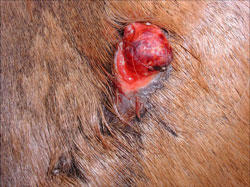
Shoulder sarcoid before Aldara
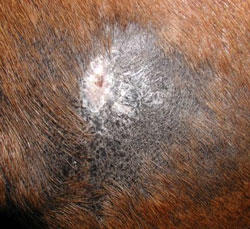
Shoulder sarcoid after Aldara
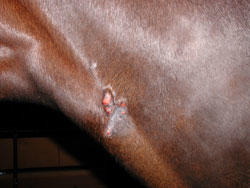
Neck sarcoid before Aldara
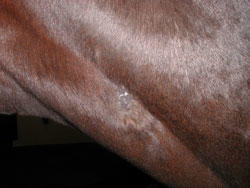
Neck sarcoid after Aldara